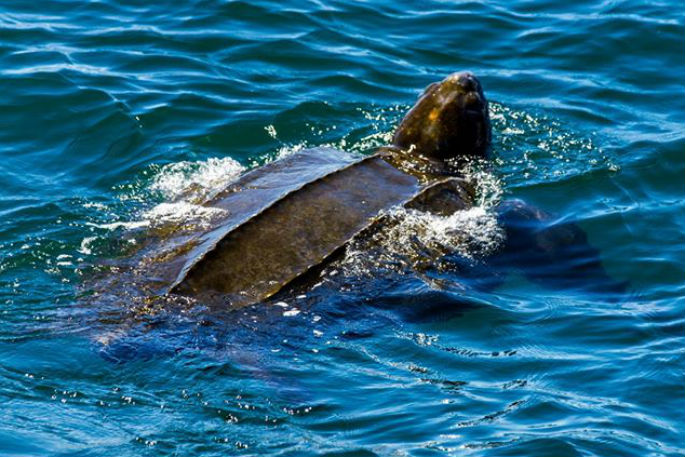Things are warming up in the Bay of plenty's big blue backyard with leatherback turtles being seen in numbers.
Bay Explorer skipper Bandon Stone released a video showing leatherback turtles to the Bay Explorer Facebook page this week. He says the normally solitary animals are now being considered as former Bay of Plenty residents.
A video form January this year showing three of the turtles close together cause a bit of stir internationally says Bandon.
'We've been talking to some scientists researchers and there's a suspicion now that they used to breed on the beaches here. But when Maori arrived and westerners as well and with the build-up of people living here they either got eaten or forced away from their breeding ground.
'But there's definitely an increase in leatherback turtles in the region. The north eastern current's come down now past Mayor Island and onto our continental shelf and they are here to eat the salps and the jellyfish.
Salps are linked strings of clear jellylike creatures that look a bit like fish eggs.The current brings the salps and jellyfish and the turtles follow the food.
'We've seen them every single day. Yesterday saw two about a kilometre away from each other.
'Seeing them together in a cluster like this would indicate they are breeding or coming together for mating. At this stage it's all supposition, but it's looking like they are coming back to their ancestral grounds in numbers. And these things are massive.”
When he first spotted one from the boat Brandon thought it was a large tractor tyre.
'The amazing thing about the leatherback turtle is they are the ones that dive the longest, and they dive the deepest,” says Brandon. 'Most other turtles have a hard keratin shell. A leatherback's shell can compress so when they dive to great depths the turtle actually shrinks in size.”
Leatherbacks can dive to more than a kilometre and can remain underwater for four to seven hours.
The Leatherback turtles are part of what has been an unprecedented week of marine life.
They saw Orca on Wednesday just offshore from Rabbit Motuotau Island and several of the big sunfish the Mola mola, which also eats jellyfish and is another endangered species.
The World Wildlife Fund page on Leatherback turtles says they are the largest sea turtle species and also one of the most migratory, crossing both the Atlantic and Pacific Oceans.
Pacific leatherbacks migrate from nesting beaches in the Coral Triangle all the way to the California coast to feed on the abundant jellyfish.
Although their distribution is wide, numbers have seriously declined during the last century as a result of intense egg collection and fisheries bycatch.
Globally, leatherback status according to IUCN is listed as Vulnerable, but many subpopulations (such as in the Pacific and Southwest Atlantic) are Critically Endangered.
Leatherback turtles consume large numbers of jellyfish which helps to keep populations of these marine organisms in check.
Marine turtles, including leatherbacks, also provide a vital source of income as a draw for ecotourism in coastal communities, especially in the Coral Triangle.
Hundreds of thousands of sea turtles a year are accidentally caught in shrimp trawl nets, on longline hooks and in fishing gillnets.
Sea turtles need to reach the surface to breathe, and therefore many drown once caught. Known as bycatch, this is a serious threat to leatherback turtles.
As fishing activity expands, this threat is more of a problem.
Sea turtles are dependent on beaches for nesting.
Sea level rise, uncontrolled coastal development, vehicle traffic on beaches, and other human activities have directly destroyed or disturbed sea turtle nesting beaches around the world.
Turtle feeding grounds such as coral reefs and sea grass beds are also damaged and destroyed by activities onshore, such as sedimentation from clearing of land and nutrient run-off from agriculture.



1 comment
Will they be lucky,
Posted on 03-12-2017 15:29 | By Marshal
What an awesome sight.. I have only seen one other in 40yrs..I hope they are lucky enough to avoid the web of nets out there..Cheers for the pic..
Leave a Comment
You must be logged in to make a comment.